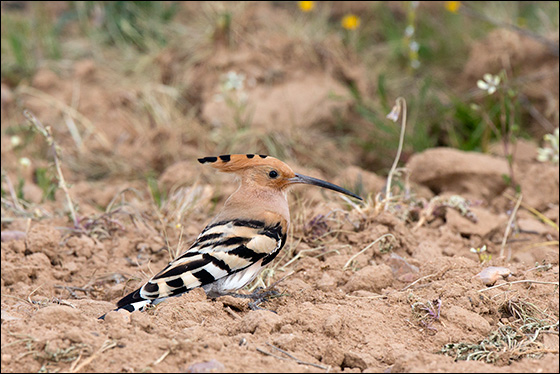Eurasian Hoopoe (Upupa epops)
With its long, slightly curved bill, the Hoopoe is adapted to feeding on the ground, both by picking insects off the surface and by probing underneath it. Despite looking fragile the bill is toughened, and the bird has a special adaptation of the jaw that enables it to open the bill while it is still in the ground, thereby making space to grab hold of a larva or grub embedded in the soil. Hoopoes are especially fond of Mole Crickets and Cockchafer larvae, which are found in the ground but leave visual clues above it, such as a recognisable entrance to a burrow. Hoopoes also eat beetles, including Stag Beetles, plus grasshoppers and crickets and other creepy-crawlies, occasionally adding in the odd lizard or frog.
Hoopoes regularly probe into dung heaps, rubbish dumps and patches of animal excreta, a practice which looks unsavoury but no doubt yields a good crop of insects. But it has given them a reputation for being unhygienic which, regrettably, is amply enforced by the fact that their nests stink. Both female parent and young are able to secrete a foul-smelling odour from their enlarged uropygial (preen) gland, which carries more than a whiff of rotting meat, enough to make you recoil violently at the entrance.
If the smell doesn’t deter predators from the nest, the youngsters have several other tricks up their sleeve. They can eject faeces with deadly accuracy towards an intruder, sometimes hitting it from 60 cm away. If this doesn’t work they can hiss like snakes, and jab with their sharp bills. Not surprisingly, the nesting success of this eye-catching and nose-catching species is higher than most.
Habitat Open country with a combination of trees or walls for nesting, and bare or sparsely vegetated ground. Includes low-intensity farmland, open woodland, orchards and olive groves.
Food Mainly insects taken from the ground or by probing in the soil.
Movements Migrates to Africa for the winter. Movement in autumn not rushed, starting any time between mid July and late October. Returns in March and April.
Voice A far-carrying, dove-like, evenly paced “Poo-poo-poo”, the sort of sound you might coo to a baby.
Pairing style Monogamous.
Nesting Solitary and territorial.
Nest In a hole, usually in a tree, but also in rocks, walls etc or in the ground.
Productivity 1-2 broods a year.
Eggs 5-8.
Incubation 16-18 days, by female, fed by the male.
Parenting style Female broods young, but both adults bring food.
Young Nest-bound, altricial and downy. They have some remarkable forms of defence (see text).
Food to young Insects, often including many larvae and pupae of butterflies and moths.
Leaving nest Young fledge at 24-28 days, and are fed by the adults for a few days thereafter.

